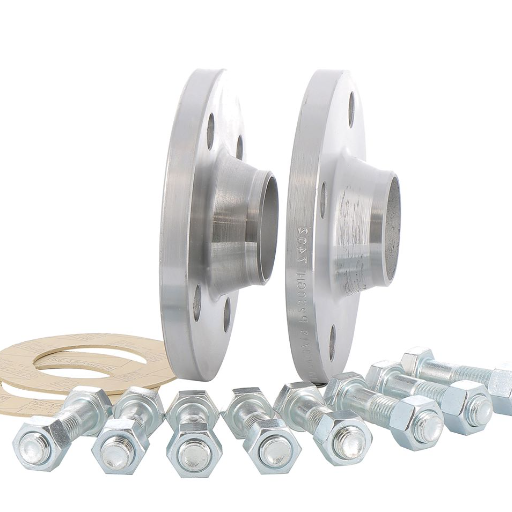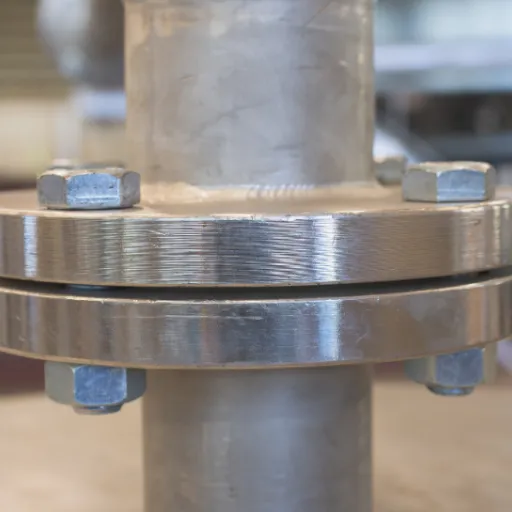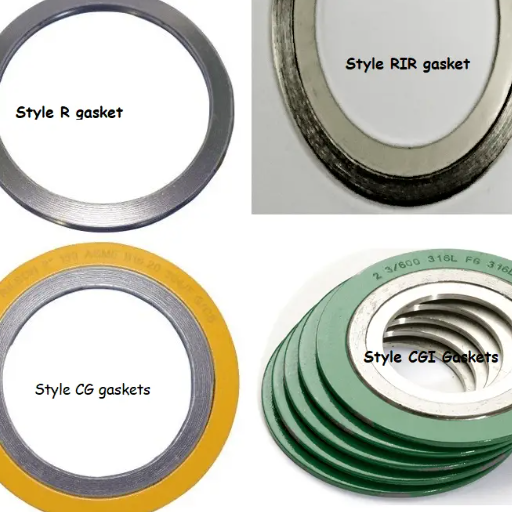When industrial piping systems are considered, the proper fit and secure connections are important. A great deal depends on understanding flange bolt dimensions and stud specifications. Whether it is a high-pressure system or a very important pipeline, a reliable flange bolt chart can really be of help. This guide goes into deep stud and flange bolt dimensions, giving you the tools to select proper items for the safety and performance of your system.
Understanding Flange and Bolt Basics

Flanges and bolts in piping systems have the function of connecting pipes, valves, or equipment securely. A flange is a plate or ring designed to connect sections of systems, and bolts are fasteners holding the flange connections together. Correct flange dimensions and bolt selections are important for two reasons:
- Achieving a tight seal that will not leak
- Maintaining system integrity at all pressures and temperatures
What are Flange Bolts?
Flange bolts are a class of special fasteners to put together flange joints of piping systems, industrial machinery, and automotive applications. The bolts have a threaded shaft and an integrated washer-shaped flange underneath the bolt head, which spreads the pressure over the whole surface of the connection.
Key Characteristics of Flange Bolts:
- Integrated flange design – Reduces likelihood of loosening over time
- Material options – Stainless steel, carbon steel, or alloy steel
- Pressure resistance – Can withstand considerable stresses and extreme temperatures
- Standard compliance – Available in ANSI, ASME, or ISO specifications
Types of Flanges and Their Applications
Flanges are major mechanical components that allow for the joining of pipes, valves, pumps, and other machinery to develop a fully functioning pipeline system. Different types of flanges find application across various industries:
| Flange Type | Key Features | Primary Applications | Industry Use |
|---|---|---|---|
| Weld Neck Flanges | Long tapering hub, butt-weld joint | High-pressure and temperature systems | Oil and gas industries |
| Slip-On Flanges | Simple, economical installation | Low pressure and temperature systems | Water systems, HVAC, fire-fighting |
| Socket Weld Flanges | Excellent leak-proof junction | Small-diameter, high-pressure piping | Chemical process lines, hydraulic systems |
| Blind Flanges | Closes/seals piping system ends | Maintenance and testing operations | Petrochemical, power generation, water treatment |
| Threaded Flanges | Screw-on installation | Low-pressure, non-critical applications | Plumbing systems, temporary installations |
| Lap Joint Flanges | Used with stub end, frequent disassembly | Systems requiring regular inspection | Food processing, pharmaceuticals |
| Orifice Flanges | Flow measurement capability | Pipeline flow measurement systems | Oil and gas handling plants |
Overview of Bolt Dimensions

Bolt dimensioning is very important for ensuring the flange connections are airtight and will not impair the structural integrity of the flanged systems. Bolts are categorized according to:
- Diameter – Determines load-bearing capacity
- Length – Ensures proper thread engagement
- Thread pitch – Affects clamping force distribution
- Material specifications – Provides temperature and corrosion resistance
Industry Standards Compliance
Common standards include ASME and ISO, which suggest bolt sizes and specify materials for construction. Recent data shows that proper selection of bolt dimensions is paramount to bear the operative load and avoid troubles like leakage or cracking due to stress.
Flange Bolt Chart Overview
Flange bolt charts are critical tools for choosing the proper bolt size and specifications for flanges in different industrial settings. These charts provide essential information for safe and efficient operations.
Key Features of a Flange Bolt Chart
| Feature | Description | Benefit |
|---|---|---|
| Complete Specifications | Detailed bolt dimensions, material grades, quantity requirements | Ensures proper component selection |
| Torque Guidelines | Proper torque values to prevent leakage and over-tightening | Maintains system integrity |
| Compatibility Information | ANSI, ASME, and international standard compliance | Guarantees correct specifications |
| Pressure Rating Categories | Classifications by pressure classes (150, 300, 600, etc.) | Simplifies material selection process |
| Easy Access | Online availability with current industry standards | Dynamic access to updated information |
Class 150 to 2500 Flange Specifications

Class 150 to 2500 flanges are made in compliance with industry standards for pressure and temperature ratings to facilitate interchangeability for a wide variety of applications. These are manufactured in varying sizes and classes, indicating the pressure limit that a flange can resist at a given temperature. Materials commonly used for fabrication of these flanges are carbon steel, stainless steel, or alloys, depending upon the working conditions, to give the maximum resistance to corrosion and wear. During installation, proper selection of gasket, bolt size, and torque value must be performed so that the flange will seal tight and not leak. Follow all standards and specifications, and these flanges will provide proper service in all sorts of industrial systems.
Common Standards: ANSI and ASME B16.5
The ANSI (American National Standards Institute) and ASME B16.5 standards are fundamental to ensuring consistency and precision in flange bolt measurements across industries.
Standard Responsibilities:
- ANSI: Oversees development of standards for products, services, and systems
- ASME B16.5: Specifically deals with pipe flanges and flanged fittings
These standards ensure components comply with highly defined criteria for design, manufacturing, and performance, securing compatibility and safety of piping systems worldwide.
Understanding Class Ratings
Class ratings are industry-accepted conditions that define an item’s ability to withstand pressure and temperature during use. The pressure is given in pounds (Class 150, Class 300, etc.), with higher ratings indicating greater pressure-temperature capability.
Sample Flange Bolt Dimensions
| Flange Size | Class Rating | Number of Bolts | Bolt Diameter | Standard Length |
|---|---|---|---|---|
| 1/2″ | Class 150 | 4 | 1/2″ | 1 1/2″ |
| 4″ | Class 150 | 8 | 5/8″ | 2 1/2″ |
| 2″ | Class 2500 | 8 | 7/8″ | 4″ |
| 4″ | Class 2500 | 8 | 1″ | 4.5″ |
Installation and Maintenance of Flange Bolts

Proper installation and maintenance of flange bolts guarantee safe and reliable performance in high-pressure systems.
Installation Best Practices
- Follow torque specifications as laid down in ANSI/ASME B16.5
- Use star or crisscross tightening pattern to distribute stress evenly
- Prevent warping through proper bolt sequence
- Apply anti-seize compounds to prevent galling
Maintenance Guidelines
- Replace bolts showing corrosion, wear, or damage
- Keep bolts clean and lubricated with appropriate compounds
- Perform periodic torque checks as part of maintenance routines
- Retorque within 24 hours of start-up for critical applications
Torque Specifications for Flange Bolts
Common Installation Mistakes to Avoid
| Mistake | Consequence | Prevention |
|---|---|---|
| Wrong Gasket Selection | Early failure, leakage | Follow manufacturer specs, ensure chemical compatibility |
| Improper Surface Preparation | Compromised seal integrity | Clean all dirt, corrosion, old gasket remnants |
| Incorrect Torque Application | Gasket damage, flange warping, leaks | Use calibrated torque wrench, follow ASME PCC-1 standards |
| Ignoring Temperature/Pressure Ratings | System failure (60% of gasket failures) | Carefully match ratings to operating conditions |
| Skipping Retorquing | Gradual loosening, sealing failure | Retorque within 24 hours of initial operation |
Best Practices for Gasket Selection
Critical factors to consider during gasket selection include:
- Operating temperature and pressure requirements
- Chemical compatibility with the media
- Material selection (graphite or spiral wound for high-temp/high-pressure)
- Proper sizing for optimal flange surface fit
- Industry standard compliance (ASME or API certifications)
Conclusion
Understanding flange bolt dimensions and proper selection is crucial for maintaining safe, reliable piping systems. By following industry standards, using appropriate charts, and implementing best practices for installation and maintenance, you can ensure optimal performance and longevity of your flange connections. Always prioritize safety and consult with qualified professionals when working with high-pressure systems.
Reference Sources
- Flange Bolt Chart Wrench Size
This guide provides detailed insights into flange bolt chart wrench sizes, offering practical tips for professionals.
Source - ISO Flanges – Technical Notes
This resource from Cornell University provides technical notes on flange dimensions, including bolts, sizes, and specifications.
Source - Flange Bolting Torque Chart
A critical tool offering recommended torque values for specific bolt sizes and materials under various conditions.
Source - Top Flange Bolt Suppliers in China
Frequently Asked Questions (FAQs)
What Are the Different Types of Flange Bolt Sizes?
Flange bolt sizes vary significantly based on application and flange type. Common types include standard ASME B16.5 bolts and those designed for specific pressure classes like ANSI 150. Dimensions include diameter and length, which are crucial for proper fit and function. Flange bolts come in different material grades affecting hardness and corrosion resistance. Always consult a flange bolt chart for appropriate size and type selection.
How to Measure Flange Diameter and Bolt Length?
To measure flange diameter, determine the outside diameter of the flange face for compatibility with corresponding pipes or fittings. Bolt length should be measured from the underside of the flange face to the bolt end, considering additional components like lock washers. Consider flange type (raised face, flat face, or ring joint) as this affects overall fit. Accurate measurements prevent leaks and issues in applications like heat exchangers.
What Is the Importance of Flange Face and Gasket in Bolt Assembly?
The flange face plays a crucial role in joint sealing, with its type (raised face or flat face) influencing gasket material and design choice. A properly chosen gasket creates an effective seal, preventing leaks in pressurized fluid or gas applications. The contact area between flange face and gasket is critical for connection integrity. Proper fastener distribution and torque application ensure uniform gasket compression, directly affecting assembly performance and reliability.
How Are Bolt Dimensions Determined for Different Flanges?
Bolt dimensions are determined based on standards such as ASME B16.5 and B16.47, which outline specifications for different flange types and corresponding bolt sizes. Factors include pressure class, flange material, and application environment. Steel pipe flanges might require bolts with specific hardness ratings for high pressure and corrosion resistance. Always refer to flange bolt charts to ensure correct specifications are met for intended applications.
What Are the Effects of Torque on Flange Bolts?
Torque directly influences clamping force and joint integrity. Proper torquing ensures even bolt tightening, maintaining flange connection integrity and preventing leaks. Insufficient torque can lead to bolt loosening, while excessive torque can cause bolt failure or flange deformation. Correct torque values are specified in manufacturer guidelines or relevant standards like ANSI. Use calibrated torque wrenches for accurate settings, particularly in high-stress environments like heat exchangers and pipelines.






